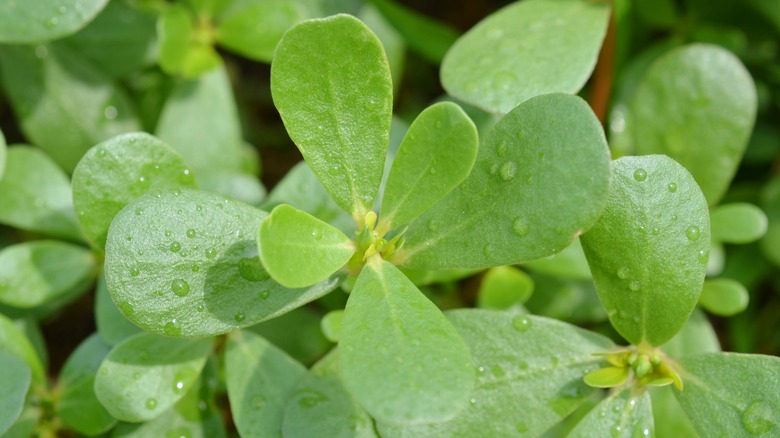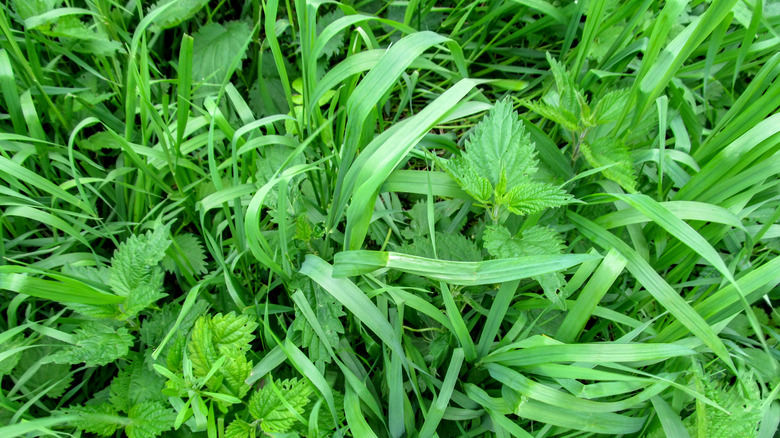What Are The Different Types Of Weeds That Grow On A Lawn?
As summer begins to emerge, you may start to notice some new plants sprouting across your lawn or landscape. Unfortunately, more often than not, these pesky little weeds are an unwanted asset to your manicured home. Although weeds are only seen as plants in nature, PennState Extension mentions that their sporadic and abundant growth can bring a variety of troubles to our yards and gardens. Beyond the unwanted look they bring to your well-kept property, they also compete for nutrients and space with the other plants in your yard, weakening them and making them more susceptible to drought, disease, and damages caused by insects.
Before diving right into your weed removal process, you must first be able to identify the type of weeds that are spreading across your yard. This Old House mentions that, depending on the type of invasive plants that emerge on your lawn, you must take a slightly distinct path for their successful removal. Helping you discover what kind of weeds are truly infesting your property, we present some of the different weed types that spring up unexpectedly.
1. Dandelion
Starting with one of the most widely recognized weeds in the United States, dandelions (Taraxcum officinale) are known for their cute yellow flowers that bloom in the spring and turn into fluffy white seeds that scatter in the summer. Dandelions do not pose any major threat, except for their rapid reproduction system that can quickly take control of your yard. Luckily, they can be easily stopped by physical removal from the earth or by using of a common herbicide.
2. Annual sow thistle
Most commonly found in the Central Valley and coastal regions of California, the annual sow thistle (Sonchus oleraceus) is a weed known for harming agricultural areas. This plant attracts pests that can cause severe damage to growing crops, rendering them useless. Because annual sow thistle is resistant to many common herbicides, the most reliable removal process involves completely extracting the plant from your yard and properly disposing of it in the garbage.
3. Nutsedge
Nutsedge (Cyperus rotundus) is a type of weed that looks very similar to grass. Unlike grass, however, it grows very aggressive, quickly infesting large areas of your lawn or landscape. Unfortunately, nutsedge is also one of the more difficult weeds to get rid of. On that end, the only way to keep it from infesting your yard is by using a post-emergent herbicide, which takes approximately a week to kill off the entire plant.
4. Black medic
Black medic weeds (Medicago lupulina) can be identified by their tear-dropped-shaped leaves and yellow, pom-pom-like flowers that emerge from the foliage. Because these weeds prefer poor soil, their presence can indicate the decreasing health of your lawn. Although improving the quality of your lawn's soil can prevent the growth of black medic, the two best ways to get rid of this invasive plant involve either physically pulling them out of the ground or using a non-selective weed killer.
5. Pigweed
Pigweed (Amaranthus retroflexus) is known for its shrub-like growth in which it emerges upward from the ground. Along with competing for nutrition with the other plants in the garden, these weeds can also be uncomfortable to work with and can travel around in your yard. Although pigweed can be easily removed from your garden by pulling up the entire plant from the ground, a non-selective herbicide that includes either glyphosate or glufosinate-ammonium is also great for the task.
6. Poison ivy
Popularly known for the painful discomfort it causes, poison ivy (Toxicodendron radicans) is a weed that is packed with toxins that cause sore rashes when they are touched by bare skin. When it comes to removing poison ivy from your yard, you must do it with specific precautions. During a physical removal, use shears or pruners to carefully cut off the top of the plant before digging out the roots below. If you'd rather use a herbicide to get rid of the weed, ensure it contains glyphosate for the most effective result.
7. Burdock
Burdock (Arctium minus Bernh) can be easily identified by its wide elephant-ear leaves that have a texture ranging between smooth and fuzzy. This type of weed usually grows in patches alongside roads and ditches. To avoid the sporadic growth and allergic reactions this weed is known for, simply digging up, hand-pulling, and plowing is the most effective way to stunt its growth. Herbicides that contain substances like dicamba, picloram, and glyphosate can also complete the task.
8. Prostrate spurge
Known for their annual summer appearance, prostrate spurge plants (Euphorbia maculata) can be easily identified by their fuzzy red stems that branch out with dense foliage of dark-green leaves. These weeds take advantage of weak spots in your yard; therefore, they can emerge in small or large patches, depending on your lawn's health. To get rid of them, simple hand removal is the easiest and most effective path to take for smaller populations. However, for larger colonies, it's best to use a weed control solution that kills the weeds and prevents their future growth.
9. Puncturevine
Under the right conditions, puncturevine (Tribulus terrestris) can quickly grow into a large yard infestation. Not only are their matted green foliage and small yellow flowers toxic to many animals, but the spine of their fruit contains spikes that can easily puncture anything that comes into contact with them. The best way to control or get rid of puncturevine in your yard involves hand removal or hoeing the weed away. You can also use some pre-emergent herbicides that contain oryzalin, benefin, or trifuralin to stop the growth of those plants.
10. Canada thistle
Originally native to Europe, the Canada thistle plant (Cirsium arvense) was brought over to North America in the 1600s and has grown aggressively since then. Their stems can range from fuzzy to smoother but are always topped off with a purple pom-pom-like flower. To get rid of it from your yard, weed killers are usually the most effective because of the extensive root system that must be extinguished with the rest of the plant.
11. Chickweed
Chickweeds (Stellaria media) are plants that grow in small mounds all around your backyard. Among their dense, green foliage, these plants also produce small, elegant flowers with five pearly white flowers. Unfortunately, while chickweed can be a delicious addition to your home-grown salad, it is still seen as an unwanted asset to have on your manicured lawn. The best way to rid your yard of chickweed is by either hand-pulling the weeds or using a pre-emergent herbicide. However, keep in mind that these techniques work best before their elegant flowers blossom.
12. Purslane
Known for its succulent-like leaves and little yellow flowers, purslane (Portulaca oleracea), is actually an edible weed that is enjoyed by many around the world. However, despite their delicious tendencies, they are known for growing in rather large patches that can bring an unwanted look to your yard or garden. The best way to get rid of these weeds is by quickly hand-pulling them. Even if the patch of purslane looks large, the space is usually only taken up by a singular place that you can easily pull.
13. Quack grass
Also known as couch grass, dog grass, or witchgrass, quack grass (Elymus repens) is one of the hardest weeds to remove from your lawn. This plant looks like grass with wide, waxy blade-like leaves and thick white roots. If you spot quack grass growing on your lawn, the best way to effectively eliminate it is not by pulling it up. Instead, try smothering it with a layer of woodchips and a black tarp or plastic until it dyes away. A weed and grass killer is also an adequate way to rid your yard of this invasive grass type.
14. Common mallow
Unlike many types of weeds, common mallow (Malva neglecta) is a plant that is seen as attractive to many people due to its unique foliage and beautiful flowers. The weed has long stems that are scattered with circular, wavy leaves and top off with beautiful little flowers between spring and fall. Although many people choose to care for these weeds, if they are unwanted, they can also be easily removed by either hand-pulling them or hoeing them out of the earth. It's best to leave chemical substances out of the removal process for this particular plant.
15. Stinging nettle
Like poison ivy, stinging nettle (Urtica dioica) also contains chemicals in its leaves that are known for causing irritation when touched by bare skin. This plant can be easily identified by its thin dark-green leaves that are toothed along the sides and pointed at the tip. To rid your yard of these bothersome plants, you can either hand-pull or hoe them out or use a systematic herbicide that takes effect through the weeds' root system and kills them from the inside.















